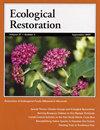Visitor Use and Activities Detected Using Trail Cameras at Forest Restoration Sites
IF 1.1
4区 环境科学与生态学
Q2 ECOLOGY
引用次数: 0
Abstract
ABSTRACT We used trail cameras to monitor human visits and activities at two sites in northeast Indiana being restored to bottomland hardwood forests. These sites, managed as nature preserves, are close to cities, where trails and parking lots have been added for ease of access. In this study, trail cameras were successfully used to capture visitation rates and activity types. The two sites had median visitor use rates of 1 and 13 visitors per day. Across both sites, “parking lot use only” (62%), hikers (30.2%), and bicyclists (5%) accounted for more than 97% of site visits. Overall, most weekday visitor-time occurred during daylight hours, peaking at lunch and evening. Mean total number of daily visitors was higher during weekends; however, total daily visitor-time did not vary between days of the week. Michaelis-Menten rarefaction models of sampling efficiency across the study’s four camera stations suggest sampling duration of 27 to 55 days to accurately estimate mean daily visitor counts and 3 to 40 days to detect half the maximal numbers of observed activities. Study estimates of visitation provide land managers with information for accommodating visitor use activities on the restored sites and offer inputs for cultural ecosystem services assessments and associated economic analyses.在森林恢复地点使用步道相机探测到的游客使用情况和活动
摘要 我们在印第安纳州东北部两处正在恢复为底层阔叶林的地点使用步道摄像机监控人类的来访和活动。这两个地点作为自然保护区进行管理,靠近城市,为了方便人们进出,还增设了小径和停车场。在这项研究中,我们成功地利用步道摄像机捕捉到了游客使用率和活动类型。两个地点的游客使用率中位数分别为每天 1 人和 13 人。在这两个景点中,"仅使用停车场"(62%)、徒步旅行者(30.2%)和自行车骑行者(5%)占景点访问量的 97% 以上。总体而言,大多数游客的工作日参观时间是在白天,高峰期在午餐和傍晚。周末的平均日游客总数较高;然而,不同工作日的日游客总停留时间并无差异。该研究的四个摄影站的取样效率的迈克尔斯-门顿稀释模型表明,取样持续时间为 27 到 55 天才能准确估计平均每日游客人数,3 到 40 天才能检测到观察到的最大活动次数的一半。对游客量的研究估算为土地管理者提供了在修复地点开展游客使用活动的信息,并为文化生态系统服务评估和相关经济分析提供了参考。
本文章由计算机程序翻译,如有差异,请以英文原文为准。
求助全文
约1分钟内获得全文
求助全文
来源期刊

Ecological Restoration
Environmental Science-Nature and Landscape Conservation
CiteScore
1.70
自引率
12.50%
发文量
24
期刊介绍:
Ecological Restoration is a forum for people advancing the science and practice of restoration ecology. It features the technical and biological aspects of restoring landscapes, as well as collaborations between restorationists and the design professions, land-use policy, the role of education, and more. This quarterly publication includes peer-reviewed science articles, perspectives and notes, book reviews, abstracts of restoration ecology progress published elsewhere, and announcements of scientific and professional meetings.
 求助内容:
求助内容: 应助结果提醒方式:
应助结果提醒方式:


